|
Attractions in Belarus
Historical places
Whether it is WWI or WWII, Napoleon war
or Northern wars - they happened here in Belarus. There is plenty of history of
Russian Socialist revolution here too. Belarus has the richest Jewish
history. Whether it is David Mayer-Lanski or David Sarnoff, Isaac Asimov or Menachem
Begin, Irving Berlin or Eliayahu Golomb, Kirk Douglas or Gwyneth Paltrow,
Haim Weizmann, Eliezer Ben-Yehuda, Shimon Peres, Marc Chagall, Micgel Kikoine,
the Chofetz Chaim, Bielski
brothers, and the first Lubavitcher Rebbe - they
were born or have roots in Belarus or within 50 miles of its current
borders. The first ever Yeshiva was built in Valozhyn, Belarus.
 There are plenty
of XII-XIV centuries Castles left in Belarus. Most of
them half destroyed. Some (in Mir, Nyasvizh, Zaslaue, Lida, Kamianec) are
reasonably preserved. Depicted on the left is Mir Castle - one of the
many former residencies of the famous Belarusian Radzivill family.
Today it is a residence of the college of architectural restoration There are plenty
of XII-XIV centuries Castles left in Belarus. Most of
them half destroyed. Some (in Mir, Nyasvizh, Zaslaue, Lida, Kamianec) are
reasonably preserved. Depicted on the left is Mir Castle - one of the
many former residencies of the famous Belarusian Radzivill family.
Today it is a residence of the college of architectural restoration
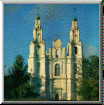 You can still find XII century orthodox churches in Hrodna, Mahilyow, Polacak (St. Sophia
Cathedral of Polacak is depicted on the right), Navahradak, etc.
There are beautiful and mighty catholic churches (XIV-XVI cc.) well preserved in Hrodna, Vitebsk,
Vidzy(!), etc. You can still find XII century orthodox churches in Hrodna, Mahilyow, Polacak (St. Sophia
Cathedral of Polacak is depicted on the right), Navahradak, etc.
There are beautiful and mighty catholic churches (XIV-XVI cc.) well preserved in Hrodna, Vitebsk,
Vidzy(!), etc.
 Depicted
on the left is the "Farny" Jesuit Cathedral in Hrodna, built in XVII-XVIIIcc by the King of Rzhech
Pospolita Polsko-Litewska - Stefan Batory. See many more of the belarusian
cathedrals and other historical buildings in our Belarusian Architecture page. Also
visit our City Guides with photos and short historical
information about many belarusian towns and cities. Depicted
on the left is the "Farny" Jesuit Cathedral in Hrodna, built in XVII-XVIIIcc by the King of Rzhech
Pospolita Polsko-Litewska - Stefan Batory. See many more of the belarusian
cathedrals and other historical buildings in our Belarusian Architecture page. Also
visit our City Guides with photos and short historical
information about many belarusian towns and cities.
If you are flying it is most likely that you will come to
our capital Minsk Although
completely destroyed during the WWII it was rebuilt in a beautiful city. As for me I like
its botanical garden. But visit the linked above page of Dzmitry Zelenko and see for
yourself :)
See also our 2003 photos of Minsk,
medieval festival in Mir and Hrodna
(picture sets 1, 2, 3,
4 and 5).
Some Belarusian tour agencies are listed here:
World War II
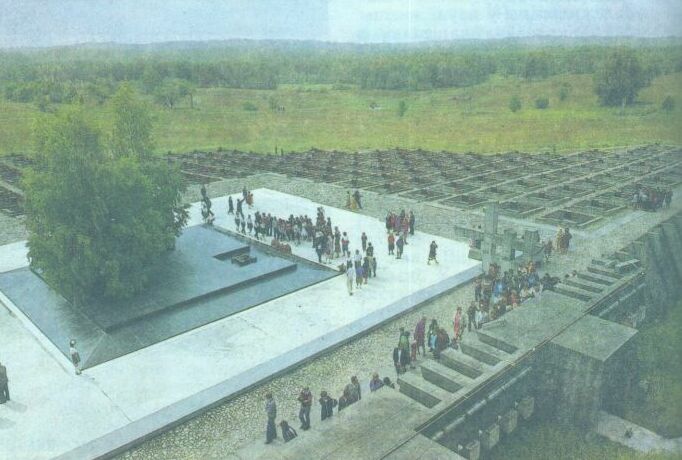
During WWII every fourth (by some accounts 1/3) citizen of Byelorussian SSR perished. Thus we do have
a lot of memorials for the victims of WWII. The most known are Khatyn',
close to Minsk, and Brest Fortress. Khatyn is a memorial to a
village burned during WWII with it's inhabitants alive by Nazi. It has a Graveyard of
Villages - each grave symbolizes one of those many Belarusian villages that have shared
their terrible fate with Khatyn.
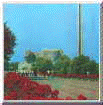 Brestskaya
Krepasc'(Brest Fortress) is famous by the deed of its heroic garrison. It was defending
their post for more than month completely cut off, surrounded by Germans, far from the
front that was moving fast to Moscow. They all perished but did not surrender. In
commemoration of this deed a tremendous memorial was arisen in Brest.
Belarusians had an unprecedented guerilla resistance scale - hundreds of thousands
of partisan fighters stayed in Belarusian woods fighting Germans. Bielski
brothers saved more than 1,200 of their fellow Jews from perishing in the
Holocaust - as many as Oscar Schindler, - the largest rescue of Jews by Jews
in all of World War II
Brestskaya
Krepasc'(Brest Fortress) is famous by the deed of its heroic garrison. It was defending
their post for more than month completely cut off, surrounded by Germans, far from the
front that was moving fast to Moscow. They all perished but did not surrender. In
commemoration of this deed a tremendous memorial was arisen in Brest.
Belarusians had an unprecedented guerilla resistance scale - hundreds of thousands
of partisan fighters stayed in Belarusian woods fighting Germans. Bielski
brothers saved more than 1,200 of their fellow Jews from perishing in the
Holocaust - as many as Oscar Schindler, - the largest rescue of Jews by Jews
in all of World War II
Nature
See our special page about The
Nature of Belarus
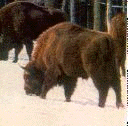 Close to Brest is a national park
"Belavezha" where the relict European relative of buffalo - Zoobr- has
survived. This park is shared between Belarus and Poland (see this polish site) and
is probably the last piece of primeval European forest. Typical landscapes include pine and mixed woods (1/3 of
territory is covered by forest), small hills (the highest point of Belarus - Navahrudak -
is 300m above the sea). Belarus is a country of thousands of lakes. You could also do some bird watching in the vast fields, forests and
marshlands of Belarus. Of the other natural attractions I can
mention a resort on lake Svisloch' with an extremely clean water. Overall Belarus has a
lot of small quiet resorts on lakes and rivers in beautiful pine forests. But do not
expect a five star service anywhere. It is reasonably clean and safe, but primitive by
western standards. The great part about Belarus is that there is no private land. So you
can camp pretty much wherever you like to. You can fish, gather berries, mushrooms and
flowers, you can daydream on the sunny edge of the forest, you can swim in any lake or
river without lifeguard whistling at you and so on and so on. For an overcrowded Europe or
Japan this might be a perfect way to get lost in nature. The time scale in such places is
unbelievably slow and relaxing. Close to Brest is a national park
"Belavezha" where the relict European relative of buffalo - Zoobr- has
survived. This park is shared between Belarus and Poland (see this polish site) and
is probably the last piece of primeval European forest. Typical landscapes include pine and mixed woods (1/3 of
territory is covered by forest), small hills (the highest point of Belarus - Navahrudak -
is 300m above the sea). Belarus is a country of thousands of lakes. You could also do some bird watching in the vast fields, forests and
marshlands of Belarus. Of the other natural attractions I can
mention a resort on lake Svisloch' with an extremely clean water. Overall Belarus has a
lot of small quiet resorts on lakes and rivers in beautiful pine forests. But do not
expect a five star service anywhere. It is reasonably clean and safe, but primitive by
western standards. The great part about Belarus is that there is no private land. So you
can camp pretty much wherever you like to. You can fish, gather berries, mushrooms and
flowers, you can daydream on the sunny edge of the forest, you can swim in any lake or
river without lifeguard whistling at you and so on and so on. For an overcrowded Europe or
Japan this might be a perfect way to get lost in nature. The time scale in such places is
unbelievably slow and relaxing.
Agro
and Eco Tourism
Because hotel industry in Belarus is pretty
poorly developed - I'm not sure if there are any hotels rated above three stars - lately a so
called agro-tourism is becoming popular. Agro Tourism is when a native
person or local of the area offers tours to their Agriculture project to
allow a person to view them growing, harvesting, and processing locally
grown foods, such as coconuts, pineapple, sugar cane, corn, or any produce
the person would not encounter in their home country. Often the farmers
would provide a home-stay opportunity and education.
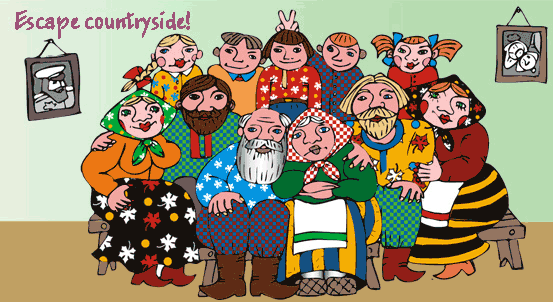
Mushroom hunting, gathering wild berries and
medicinal plants with experts are some ways to spend time on such tours.
The thing is that there is pretty
much no private land in Belarus. You can camp in any forest, lie down and
dream in every meadow, swim in every lake. Some general common sense fire
hazard and nature conservation rules apply and that's it. Agro tourism
allows you to live in Belarusian village - out there in nature. You get to
eat simple Belarusian peasant food, perhaps even help in the fields or
with cattle. This takes you from 21st century into 18th within a day.
Forget SMS :) Here are few places that provide such services:
Healthcare
Tourism
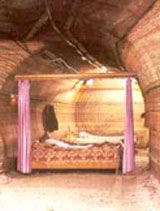 There
are some unique places in Belarus that provide health benefits. One such famous
place is for people with respiratory diseases - asthma etc. - in Salihorsk. They
have man-made caverns - former salt excavation places - where a specific inhalation
techniques are used to treat respiratory diseases, so called speleotherapy.
Dentistry is lately on the rise in Belarus. One can do the same procedure as in
US some 10 times cheaper using modern materials and techniques. And just general
health spas with hydro-massage, sauna, different medical prophylactic
procedures, like oxygen cocktails, inhalation, specific diets -n are widely
available for pretty low fee as compared to the West. There
are some unique places in Belarus that provide health benefits. One such famous
place is for people with respiratory diseases - asthma etc. - in Salihorsk. They
have man-made caverns - former salt excavation places - where a specific inhalation
techniques are used to treat respiratory diseases, so called speleotherapy.
Dentistry is lately on the rise in Belarus. One can do the same procedure as in
US some 10 times cheaper using modern materials and techniques. And just general
health spas with hydro-massage, sauna, different medical prophylactic
procedures, like oxygen cocktails, inhalation, specific diets -n are widely
available for pretty low fee as compared to the West.
 This file is a part of the Virtual
Guide to Belarus - a collaborative project of Belarusian
scientists and professionals abroad. VG brings you the most extensive compilation
of the information about Belarus on the Web. This file is a part of the Virtual
Guide to Belarus - a collaborative project of Belarusian
scientists and professionals abroad. VG brings you the most extensive compilation
of the information about Belarus on the Web.
Please send your comments to the authors of VG to
Belarus 
History | Statehood | Culture | Law
and Politics | Cities | Nature and Geography | Travel | Global Resources | Dictionaries | Chernobyl | Genealogy | Industry | New
 VG to Belarus
VG to Belarus
Disclaimer
|